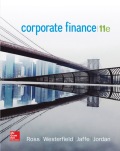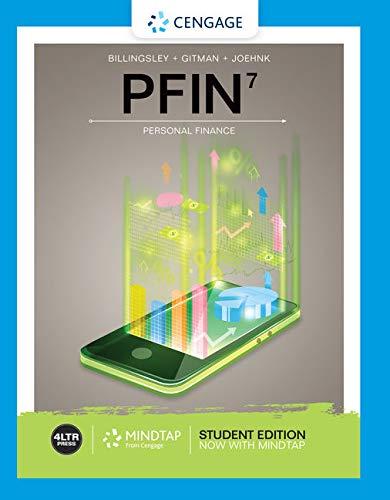
EBK CORPORATE FINANCE
11th Edition
ISBN: 8220102798878
Author: Ross
Publisher: YUZU
expand_more
expand_more
format_list_bulleted
Question
Chapter 11, Problem 25QP
Summary Introduction
To determine: The Covariance and Correlation.
Introduction: Covariance simplifies the idea of change to different arbitrary variables. Rather than estimating the vacillation of solitary arbitrary variables, it also measures the change of two factors with each other. Correlation is a numerical connection between the prices of asset. A correlation is positive if the shifts between the two or more variables are a similar way and negative if the variable shifts in opposite path. Zero correlation means there is no correlation between the variables.
Expert Solution & Answer
Want to see the full answer?
Check out a sample textbook solution
Students have asked these similar questions
Suppose that you are a U.S.-based importer of goods from the United Kingdom. You expect the value of the pound to increase against the U.S. dollar over the next 30 days. You will be making payment on a shipment of imported goods in 30 days and want to hedge your currency exposure. The U.S. risk-free rate is 5.5 percent, and the U.K. risk-free rate is 4.5 percent. These rates are expected to remain unchanged over the next month. The current spot rate is $1.90.
1.Move forward 10 days. The spot rate is $1.93. Interest rates are unchanged. Calculate the value of your forward position. Do not round intermediate calculations. Round your answer to 4 decimal places.
Don't solve.
I mistakenly submitted blurr image please comment i will write values.
please dont Solve with incorrect values otherwise unhelpful.
The image is blurr please comment i will write values.
please dont Solve with incorrect values otherwise unhelpful.
Chapter 11 Solutions
EBK CORPORATE FINANCE
Ch. 11 - Diversifiable and Nondiversifiable Risks In broad...Ch. 11 - Systematic versus Unsystematic Risk Classify the...Ch. 11 - Expected Portfolio Returns If a portfolio has a...Ch. 11 - Diversification True or false: The most important...Ch. 11 - Portfolio Risk If a portfolio has a positive...Ch. 11 - Beta and CAPM Is it possible that a risky asset...Ch. 11 - Covariance Briefly explain why the covariance of a...Ch. 11 - Prob. 8CQCh. 11 - Prob. 9CQCh. 11 - Prob. 10CQ
Ch. 11 - Determining Portfolio Weights What are the...Ch. 11 - Portfolio Expected Return You own a portfolio that...Ch. 11 - Portfolio Expected Return You own a portfolio that...Ch. 11 - Portfolio Expected Return You have 10,000 to...Ch. 11 - Prob. 5QPCh. 11 - Calculating Returns and Standard Deviations Based...Ch. 11 - Calculating Expected Returns A portfolio is...Ch. 11 - Returns and Standard Deviations Consider the...Ch. 11 - Returns and Standard Deviations Consider the...Ch. 11 - Calculating Portfolio Betas You own a stock...Ch. 11 - Calculating Portfolio Betas You own a portfolio...Ch. 11 - Using CAPM A stock has a beta of 1.15, the...Ch. 11 - Using CAPM A stock has an expected return of 13.4...Ch. 11 - Using CAPM A stock has an expected return of 13.4...Ch. 11 - Using CAPM A stock has an expected return of 11.2...Ch. 11 - Prob. 16QPCh. 11 - Prob. 17QPCh. 11 - Reward-to-Risk Ratios Stock Y has a beta of 1.20...Ch. 11 - Prob. 19QPCh. 11 - Portfolio Returns Using information from the...Ch. 11 - Prob. 21QPCh. 11 - Portfolio Returns and Deviations Consider the...Ch. 11 - Analyzing a Portfolio You want to create a...Ch. 11 - Prob. 24QPCh. 11 - Prob. 25QPCh. 11 - Prob. 26QPCh. 11 - Prob. 27QPCh. 11 - Prob. 28QPCh. 11 - Correlation and Beta You have been provided the...Ch. 11 - CML The market portfolio has an expected return of...Ch. 11 - Beta and CAPM A portfolio that combines the...Ch. 11 - Beta and CAPM Suppose the risk-free rate is 4.7...Ch. 11 - Systematic versus Unsystematic Risk Consider the...Ch. 11 - SML Suppose you observe the following situation:...Ch. 11 - Prob. 35QPCh. 11 - Prob. 36QPCh. 11 - Prob. 37QPCh. 11 - Minimum Variance Portfolio Assume Stocks A and 8...Ch. 11 - Prob. 1MCCh. 11 - Prob. 2MC
Knowledge Booster
Similar questions
- Question 6 A five-year $50,000 endowment insurance for (60) has $1,000 underwriting expenses, 25% of the first premium is commission for the agent of record and renewal expenses are 5% of subsequent premiums. Write the gross future loss random variable: Presuming a portfolio of 10,000 identical and independent policies, the expected loss and the variance of the loss of the portfolio are given below (note that the premium basis is not given or needed): E[L] = 10,000(36,956.49 - 3.8786P) V[L] 10,000 (50,000 + 14.52P)². 0.00095 Find the premium that results in a 97.5% probability of profit (i.e. ¹ (0.975) = 1.96). Premium: Please show your work belowarrow_forwardWhat corporate finance?? can you explain this? fully no aiarrow_forwardWhat is corporate finance? how this is usefull?arrow_forward
- Pam and Jim are saving money for their two children who they plan to send to university.The eldest child will enter university in 5 years while the younger will enter in 7 years. Each child is expected spend four years at university. University fees are currently R20 000 per year and are expected to grow at 5% per year. These fees are paid at the beginning of each year.Pam and Jim currently have R40 000 in their savings and their plan is to save a fixed amount each year for the next 5 years. The first deposit taking place at the end of the current year and the last deposit at the date the first university fees are paid.Pam and Jim expect to earn 10% per year on their investments.What amount should they invest each year to meet the cost of their children’s university fees?arrow_forwardPam and Jim are saving money for their two children who they plan to send to university.The eldest child will enter university in 5 years while the younger will enter in 7 years. Each child is expected spend four years at university. University fees are currently R20 000 per year and are expected to grow at 5% per year. These fees are paid at the beginning of each year.Pam and Jim currently have R40 000 in their savings and their plan is to save a fixed amount each year for the next 5 years. The first deposit taking place at the end of the current year and the last deposit at the date the first university fees are paid.Pam and Jim expect to earn 10% per year on their investments.What amount should they invest each year to meet the cost of their children’s university fees?arrow_forwardYou make a loan of R100 000, with annual payments being made at the end of each year for the next 5 years at a 10% interest rate. How much interest is paid in the second year?arrow_forward
- Dr Z. Mthembu is the owner of Mr Granite, a business in the Western Cape. After more than 28 years of operation, the business is thinking about taking on a new project that would provide a profitable new clientele. With only R1.5 million in resources, the company is now working on two competing projects. The starting costs for Project X and Project Y are R625,000 and R600000, respectively. These projected are estimated for the next 7 years timeframe. According to SARS, the tax rate is 28%, and a discount rate of 11.25% is applied.Projects X Project YProject X Project Y129000 145000154000 145000312000 145000168000 14500098250 14500088750 14500016050 145000arrow_forwardDr Z. Mthembu is the owner of Mr Granite, a business in the Western Cape. After more than 28 years of operation, the business is thinking about taking on a new project that would provide a profitable new clientele. With only R1.5 million in resources, the company is now working on two competing projects. The starting costs for Project X and Project Y are R625,000 and R600000, respectively. These projected are estimated for the next 7 years timeframe. According to SARS, the tax rate is 28%, and a discount rate of 11.25% is applied.Projects X Project YProject X Project Y129000 145000154000 145000312000 145000168000 14500098250 14500088750 14500016050 145000arrow_forwardDr Z. Mthembu is the owner of Mr Granite, a business in the Western Cape. After more than 28 years of operation, the business is thinking about taking on a new project that would provide a profitable new clientele. With only R1.5 million in resources, the company is now working on two competing projects. The starting costs for Project X and Project Y are R625,000 and R600000, respectively. These projected are estimated for the next 7 years timeframe. According to SARS, the tax rate is 28%, and a discount rate of 11.25% is applied.Projects X Project YProject X Project Y129000 145000154000 145000312000 145000168000 14500098250 14500088750 14500016050 145000arrow_forward
- Dr Z. Mthembu is the owner of Mr Granite, a business in the Western Cape. After more than 28 years of operation, the business is thinking about taking on a new project that would provide a profitable new clientele. With only R1.5 million in resources, the company is now working on two competing projects. The starting costs for Project X and Project Y are R625,000 and R600000, respectively. These projected are estimated for the next 7 years timeframe. According to SARS, the tax rate is 28%, and a discount rate of 11.25% is applied.Projects X Project YProject X Project Y129000 145000154000 145000312000 145000168000 14500098250 14500088750 14500016050 145000arrow_forwardAn investor buys 100 shares of a $40 stock that pays an annual cash dividend of $2 a share (a 5 percent dividend yield) and signs up for the DRIP. a. If neither the dividend nor the price changes, how many shares will the investor have at the end of 10 years? How much will the position in the stock be worth? Answer: 5.000 shares purchased in year 1 5.250 shares purchased in year 2 6.078 shares purchased in year 5 62.889 total shares purchased b. If the price of the stock rises by 6 percent annually but the dividend remains at $2 a share, how many shares are purchased each year for the next 10 years? How much is the total position worth at the end of 10 years? Answer: 4.717 shares purchased in year 1 4.592 shares in year 3 3.898 shares in year 10 Value of position: $10,280 c. If the price of the stock rises by 6 percent annually but the dividend rises by only 3 percent annually, how many shares are purchased each year for the next 10 years? How much is the total position worth at the…arrow_forwardDr Z. Mthembu is the owner of Mr Granite, a business in the Western Cape. After more than 28 years of operation, the business is thinking about taking on a new project that would provide a profitable new clientele. With only R1.5 million in resources, the company is now working on two competing projects. The starting costs for Project X and Project Y are R625,000 and R600000, respectively. These projected are estimated for the next 7 years timeframe. According to SARS, the tax rate is 28%, and a discount rate of 11.25% is applied.Projects X Project YProject X Project Y129000 145000154000 145000312000 145000168000 14500098250 14500088750 14500016050 145000 Calculate the IRR for the two proposed Projectsarrow_forward
arrow_back_ios
SEE MORE QUESTIONS
arrow_forward_ios
Recommended textbooks for you
 Pfin (with Mindtap, 1 Term Printed Access Card) (...FinanceISBN:9780357033609Author:Randall Billingsley, Lawrence J. Gitman, Michael D. JoehnkPublisher:Cengage Learning
Pfin (with Mindtap, 1 Term Printed Access Card) (...FinanceISBN:9780357033609Author:Randall Billingsley, Lawrence J. Gitman, Michael D. JoehnkPublisher:Cengage Learning

Pfin (with Mindtap, 1 Term Printed Access Card) (...
Finance
ISBN:9780357033609
Author:Randall Billingsley, Lawrence J. Gitman, Michael D. Joehnk
Publisher:Cengage Learning